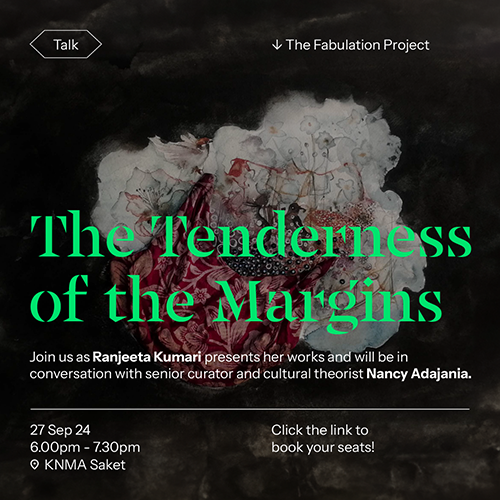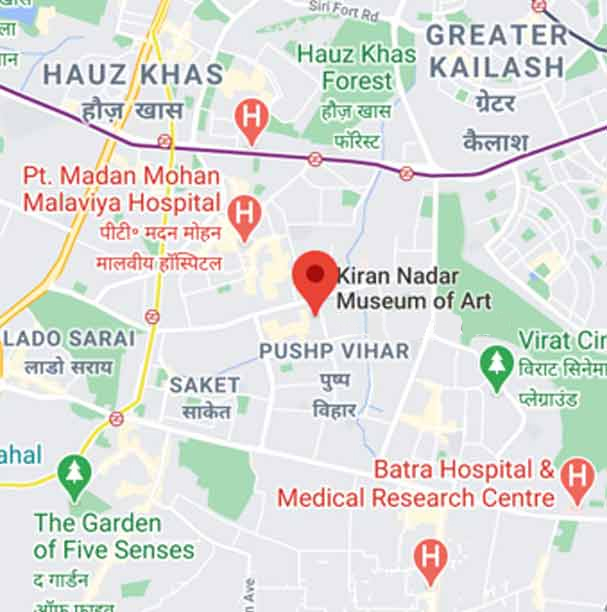- Home
- Tenderness of Margins
LECTURES / SYMPOSIUMS
Talks
Tenderness of Margins
The Fabulation Project series
27th September 2024
6:00 PM - 07:30 PM
KNMA Saket
20 September 2024

Join us for yet another engaging session from our artist talk series: THE FABULATION PROJECT. It is a series of conversations and encounters exploring contemporaneity in the arts practices, that are also a work of story making for a 'people to come', stories which they shall inherit. In an attempt to contextualise contemporary art practice this series of talks engages with story teller and story making as central and crucial to the discourses. So, we try to unravel layers of an artist’s body of work and look for what they narrate (or choose not to) about the times we live in.
Ranjeeta Kumari will present her works and be in conversation with senior curator and cultural theorist Nancy Adajania
Photo courtesy -
Artist: Ranjeeta Kumari
Ranjeeta Kumari
Kumari Ranjeeta (b.1983) is an artist from Patna, Bihar. Her art combines different mediums like painting, installation, photography, and collective projects. She uses various materials such as found objects, textiles, watercolours, and videos. Ranjeeta's artistic practice investigates questions concerning the conditions of humanity, labour, and marginalization, while engaging issues of aesthetics, culture, politics. She received her BFA in painting from the College of Arts and Crafts, Patna, India, in 2008. She then moved to Delhi with a junior fellowship awarded by the Government of India. In 2016 she graduated with a Masters in Fine Art (Research Programme) from the School of Humanities and Social Science, Shiv Nadar University, Greater Noida.
She has participated in numerous groups shows India and abroad. Her recent exhibitions include in Under Development Paradox" SAVV Contemporary Berlin, Germany. Woman Is as Woman Does, curated by Nancy Adajania, JNAF Mumbai and CSMVS Mumbai, The Chaos Trilogy: Disorder Under Heaven, curated by Premjish Achari, The Guild, Alibaug, ‘Plea to the Foreigner’ for Biennale Africaine De La Photographie curated by Prabhakar Kamble and ‘Viral Vacuum’ by art historian Mara Johanna Komel, The Showroom London. Selected solo exhibitions include Labour of the Unseen - Sujani Nihilism in Craft; River with a Thousand Holes; Clark House Initiative, Mumbai, 2016; Stories My Country Told Me, Asian Cultural Centre, Gwangju, South Korea, 2016; And I Laid Traps for Troubadours, Kadist Art Foundation, Paris, and Clark House Initiative, Mumbai, 2014
Nancy Adajania
Nancy Adajania is a Bombay-based cultural theorist and curator. She was Joint Artistic Director of the 9th Gwangju Biennale, South Korea (2012). She has curated a number of exhibitions including, 'One hundred Years and Counting: Rescripting K G Subramanyan' (Emami with Seagull, 2024) and ‘Woman Is As Woman Does’ (CSMVS Museum with JNAF, 2022), a first-ever intergenerational mapping of the works of Indian women artists, filmmakers and activists against the backdrop of the women's movement in India. Adajania's other major research-based exhibitions include the retrospectives of artists Navjot Altaf, Sudhir Patwardhan, Mehlli Gobhai and Nelly Sethna. She has proposed several new theoretical models through her extensive writings on subaltern art, media art, public art, collaborative art, transcultural art and the biennale culture in the Global South. For more than two decades, she has written on the practices of women artists of several generations by deploying a trans-disciplinary approach that melds art history, feminist theory, anthropology, activism and philosophy.
Adajania has edited two transdisciplinary anthologies, Some things that only art can do: A Lexicon of affective knowledge and Totems and Taboos: What can and cannot be done for the Raza Foundation (2017/2018). She conceptualised and led the online workshop Once Upon a Cultural Famine: A Curatorial Thought Experiment for the Kochi Biennale Foundation (2021). Her curatorial monograph on the Sudhir Patwardhan retrospective (‘Walking Through Soul City’, 2019), includes new readings of the artist’s practice, as well as a rare contextual mapping of the relationship between Leftist politics and art, annotated through a translation of primary textual material from Marathi activist literature.


